2021 NISSAN ARMADA towing capacity
[x] Cancel search: towing capacityPage 30 of 603
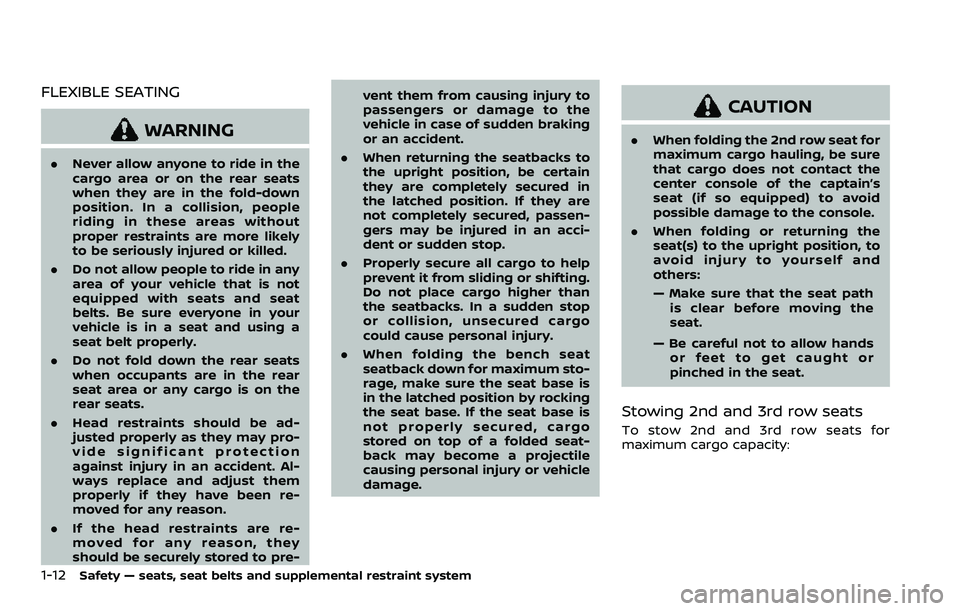
1-12Safety — seats, seat belts and supplemental restraint system
FLEXIBLE SEATING
WARNING
.Never allow anyone to ride in the
cargo area or on the rear seats
when they are in the fold-down
position. In a collision, people
riding in these areas without
proper restraints are more likely
to be seriously injured or killed.
. Do not allow people to ride in any
area of your vehicle that is not
equipped with seats and seat
belts. Be sure everyone in your
vehicle is in a seat and using a
seat belt properly.
. Do not fold down the rear seats
when occupants are in the rear
seat area or any cargo is on the
rear seats.
. Head restraints should be ad-
justed properly as they may pro-
vide significant protection
against injury in an accident. Al-
ways replace and adjust them
properly if they have been re-
moved for any reason.
. If the head restraints are re-
moved for any reason, they
should be securely stored to pre- vent them from causing injury to
passengers or damage to the
vehicle in case of sudden braking
or an accident.
. When returning the seatbacks to
the upright position, be certain
they are completely secured in
the latched position. If they are
not completely secured, passen-
gers may be injured in an acci-
dent or sudden stop.
. Properly secure all cargo to help
prevent it from sliding or shifting.
Do not place cargo higher than
the seatbacks. In a sudden stop
or collision, unsecured cargo
could cause personal injury.
. When folding the bench seat
seatback down for maximum sto-
rage, make sure the seat base is
in the latched position by rocking
the seat base. If the seat base is
not properly secured, cargo
stored on top of a folded seat-
back may become a projectile
causing personal injury or vehicle
damage.
CAUTION
.When folding the 2nd row seat for
maximum cargo hauling, be sure
that cargo does not contact the
center console of the captain’s
seat (if so equipped) to avoid
possible damage to the console.
. When folding or returning the
seat(s) to the upright position, to
avoid injury to yourself and
others:
— Make sure that the seat path
is clear before moving the
seat.
— Be careful not to allow hands or feet to get caught or
pinched in the seat.
Stowing 2nd and 3rd row seats
To stow 2nd and 3rd row seats for
maximum cargo capacity:
Page 509 of 603

10 Technical and consumer information
Capacities and
recommended fluids/lubricants .................................... 10-2Fuel information .................................................................. 10-4
Engine oil and oil filter recommendation ........ 10-6
Air conditioning system refrigerant and
oil recommendations ....................................................... 10-7
Specifications ........................................................................\
........ 10-8 Engine ........................................................................\
.................. 10-8
Wheels and tires .................................................................. 10-9
Dimensions ........................................................................\
.. 10-10
When traveling or registering in
another country ..................................................................... 10-11
Vehicle identification .......................................................... 10-11 Vehicle Identification Number
(VIN) plate ........................................................................\
...... 10-11
Vehicle identification number
(chassis number) ............................................................. 10-11
Engine serial number ................................................... 10-12
F.M.V.S.S./C.M.V.S.S. certification label ............. 10-12
Emission control information label .................. 10-12
Tire and loading information label ................... 10-13
Air conditioner specification label ..................... 10-13
Installing front license plate ......................................... 10-15 Vehicle loading information ......................................... 10-15
Terms ........................................................................\
............. 10-15
Vehicle load capacity ................................................ 10-17
Securing the load ......................................................... 10-18
Loading tips ...................................................................... 10-18
Measurement of weights ....................................... 10-19
Towing a trailer ...................................................................... 10-19 Maximum load limits ................................................. 10-19
Maximum Gross Vehicle Weight (GVW)/
maximum Gross Axle Weight (GAW) .............. 10-21
Towing load/specification ..................................... 10-23
Towing safety ................................................................ 10-24
Flat towing ........................................................................\
. 10-35
Uniform tire quality grading ........................................ 10-36 Treadwear ........................................................................\
.. 10-36
Traction AA, A, B and C ........................................... 10-36
Temperature A, B and C ......................................... 10-36
Emission control system warranty ......................... 10-37
Reporting safety defects ................................................ 10-37
Readiness for Inspection/Maintenance
(I/M) test ........................................................................\
............... 10-38
Event Data Recorders (EDR) ......................................... 10-39
Owner’s Manual/Service Manual
order information ................................................................. 10-40
Page 525 of 603
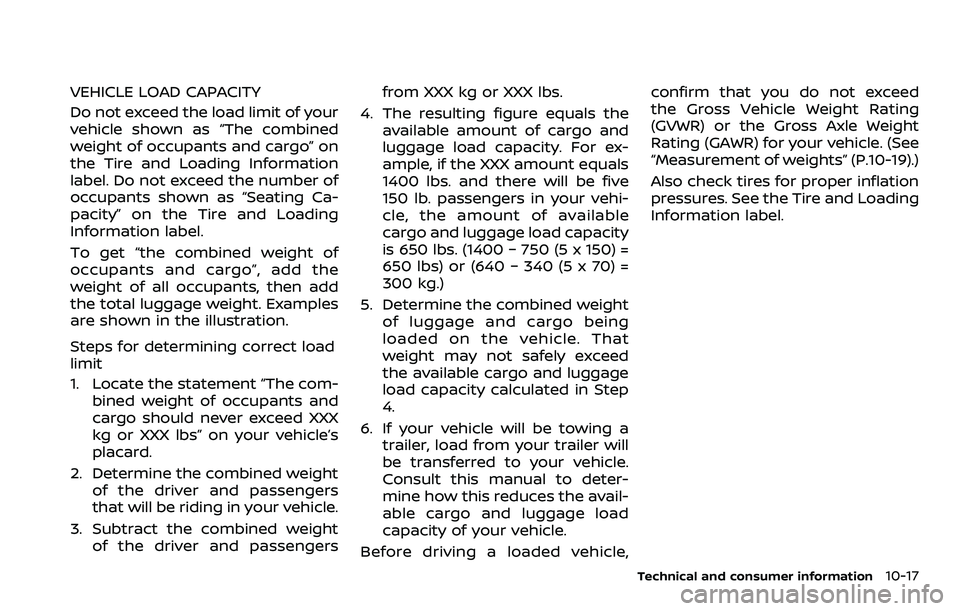
VEHICLE LOAD CAPACITY
Do not exceed the load limit of your
vehicle shown as “The combined
weight of occupants and cargo” on
the Tire and Loading Information
label. Do not exceed the number of
occupants shown as “Seating Ca-
pacity” on the Tire and Loading
Information label.
To get “the combined weight of
occupants and cargo”, add the
weight of all occupants, then add
the total luggage weight. Examples
are shown in the illustration.
Steps for determining correct load
limit
1. Locate the statement “The com-bined weight of occupants and
cargo should never exceed XXX
kg or XXX lbs” on your vehicle’s
placard.
2. Determine the combined weight of the driver and passengers
that will be riding in your vehicle.
3. Subtract the combined weight of the driver and passengers from XXX kg or XXX lbs.
4. The resulting figure equals the available amount of cargo and
luggage load capacity. For ex-
ample, if the XXX amount equals
1400 lbs. and there will be five
150 lb. passengers in your vehi-
cle, the amount of available
cargo and luggage load capacity
is 650 lbs. (1400 − 750 (5 x 150) =
650 lbs) or (640 − 340 (5 x 70) =
300 kg.)
5. Determine the combined weight of luggage and cargo being
loaded on the vehicle. That
weight may not safely exceed
the available cargo and luggage
load capacity calculated in Step
4.
6. If your vehicle will be towing a trailer, load from your trailer will
be transferred to your vehicle.
Consult this manual to deter-
mine how this reduces the avail-
able cargo and luggage load
capacity of your vehicle.
Before driving a loaded vehicle, confirm that you do not exceed
the Gross Vehicle Weight Rating
(GVWR) or the Gross Axle Weight
Rating (GAWR) for your vehicle. (See
“Measurement of weights” (P.10-19).)
Also check tires for proper inflation
pressures. See the Tire and Loading
Information label.
Technical and consumer information10-17
Page 529 of 603
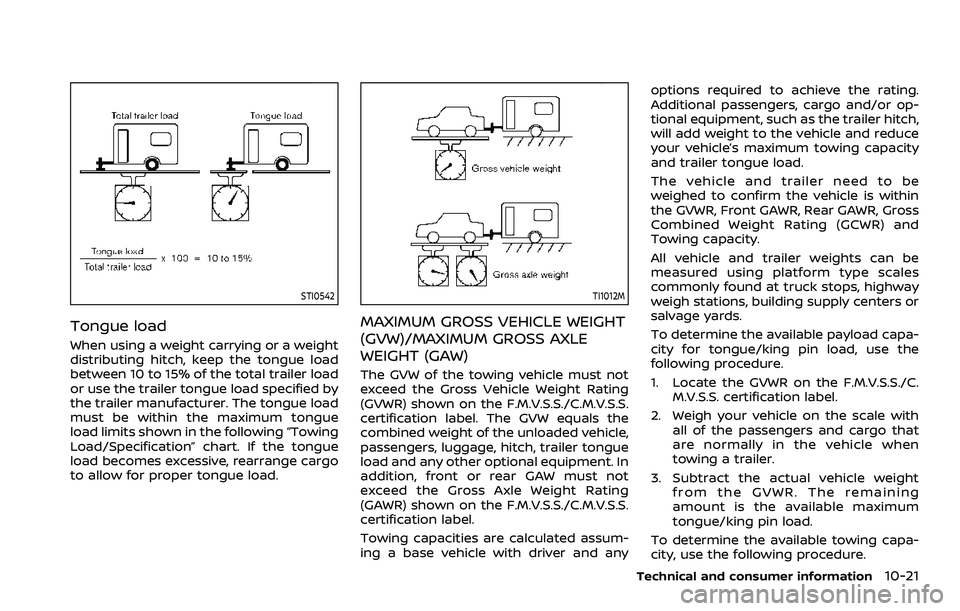
STI0542
Tongue load
When using a weight carrying or a weight
distributing hitch, keep the tongue load
between 10 to 15% of the total trailer load
or use the trailer tongue load specified by
the trailer manufacturer. The tongue load
must be within the maximum tongue
load limits shown in the following “Towing
Load/Specification” chart. If the tongue
load becomes excessive, rearrange cargo
to allow for proper tongue load.
TI1012M
MAXIMUM GROSS VEHICLE WEIGHT
(GVW)/MAXIMUM GROSS AXLE
WEIGHT (GAW)
The GVW of the towing vehicle must not
exceed the Gross Vehicle Weight Rating
(GVWR) shown on the F.M.V.S.S./C.M.V.S.S.
certification label. The GVW equals the
combined weight of the unloaded vehicle,
passengers, luggage, hitch, trailer tongue
load and any other optional equipment. In
addition, front or rear GAW must not
exceed the Gross Axle Weight Rating
(GAWR) shown on the F.M.V.S.S./C.M.V.S.S.
certification label.
Towing capacities are calculated assum-
ing a base vehicle with driver and anyoptions required to achieve the rating.
Additional passengers, cargo and/or op-
tional equipment, such as the trailer hitch,
will add weight to the vehicle and reduce
your vehicle’s maximum towing capacity
and trailer tongue load.
The vehicle and trailer need to be
weighed to confirm the vehicle is within
the GVWR, Front GAWR, Rear GAWR, Gross
Combined Weight Rating (GCWR) and
Towing capacity.
All vehicle and trailer weights can be
measured using platform type scales
commonly found at truck stops, highway
weigh stations, building supply centers or
salvage yards.
To determine the available payload capa-
city for tongue/king pin load, use the
following procedure.
1. Locate the GVWR on the F.M.V.S.S./C.
M.V.S.S. certification label.
2. Weigh your vehicle on the scale with all of the passengers and cargo that
are normally in the vehicle when
towing a trailer.
3. Subtract the actual vehicle weight from the GVWR. The remaining
amount is the available maximum
tongue/king pin load.
To determine the available towing capa-
city, use the following procedure.
Technical and consumer information10-21
Page 530 of 603
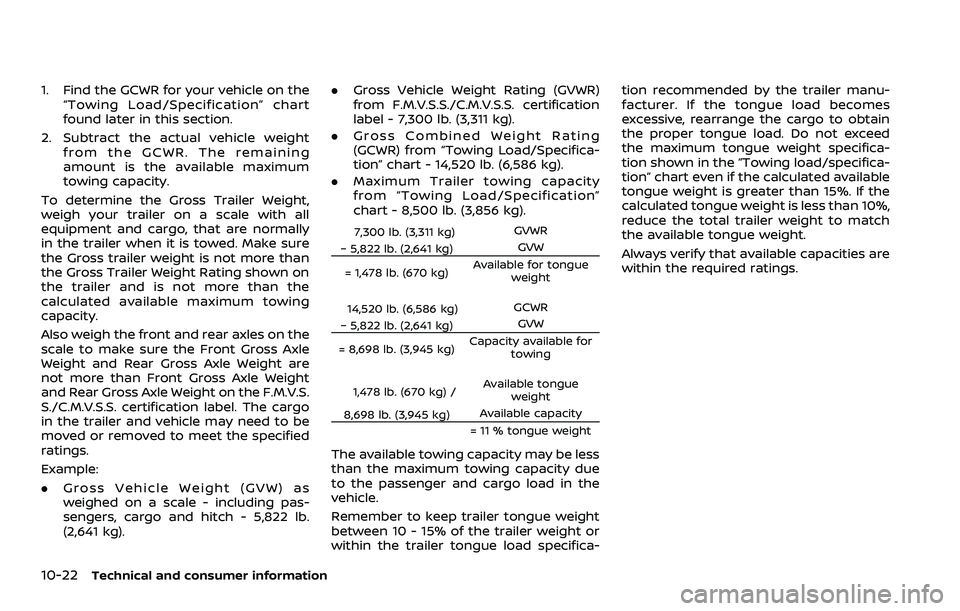
10-22Technical and consumer information
1. Find the GCWR for your vehicle on the“Towing Load/Specification” chart
found later in this section.
2. Subtract the actual vehicle weight from the GCWR. The remaining
amount is the available maximum
towing capacity.
To determine the Gross Trailer Weight,
weigh your trailer on a scale with all
equipment and cargo, that are normally
in the trailer when it is towed. Make sure
the Gross trailer weight is not more than
the Gross Trailer Weight Rating shown on
the trailer and is not more than the
calculated available maximum towing
capacity.
Also weigh the front and rear axles on the
scale to make sure the Front Gross Axle
Weight and Rear Gross Axle Weight are
not more than Front Gross Axle Weight
and Rear Gross Axle Weight on the F.M.V.S.
S./C.M.V.S.S. certification label. The cargo
in the trailer and vehicle may need to be
moved or removed to meet the specified
ratings.
Example:
. Gross Vehicle Weight (GVW) as
weighed on a scale - including pas-
sengers, cargo and hitch - 5,822 lb.
(2,641 kg). .
Gross Vehicle Weight Rating (GVWR)
from F.M.V.S.S./C.M.V.S.S. certification
label - 7,300 lb. (3,311 kg).
. Gross Combined Weight Rating
(GCWR) from “Towing Load/Specifica-
tion” chart - 14,520 lb. (6,586 kg).
. Maximum Trailer towing capacity
from “Towing Load/Specification”
chart - 8,500 lb. (3,856 kg).
7,300 lb. (3,311 kg) GVWR
− 5,822 lb. (2,641 kg) GVW
= 1,478 lb. (670 kg) Available for tongue
weight
14,520 lb. (6,586 kg) GCWR
− 5,822 lb. (2,641 kg) GVW
= 8,698 lb. (3,945 kg) Capacity available for
towing
1,478 lb. (670 kg) / Available tongue
weight
8,698 lb. (3,945 kg) Available capacity
= 11 % tongue weight
The available towing capacity may be less
than the maximum towing capacity due
to the passenger and cargo load in the
vehicle.
Remember to keep trailer tongue weight
between 10 - 15% of the trailer weight or
within the trailer tongue load specifica- tion recommended by the trailer manu-
facturer. If the tongue load becomes
excessive, rearrange the cargo to obtain
the proper tongue load. Do not exceed
the maximum tongue weight specifica-
tion shown in the “Towing load/specifica-
tion” chart even if the calculated available
tongue weight is greater than 15%. If the
calculated tongue weight is less than 10%,
reduce the total trailer weight to match
the available tongue weight.
Always verify that available capacities are
within the required ratings.
Page 531 of 603
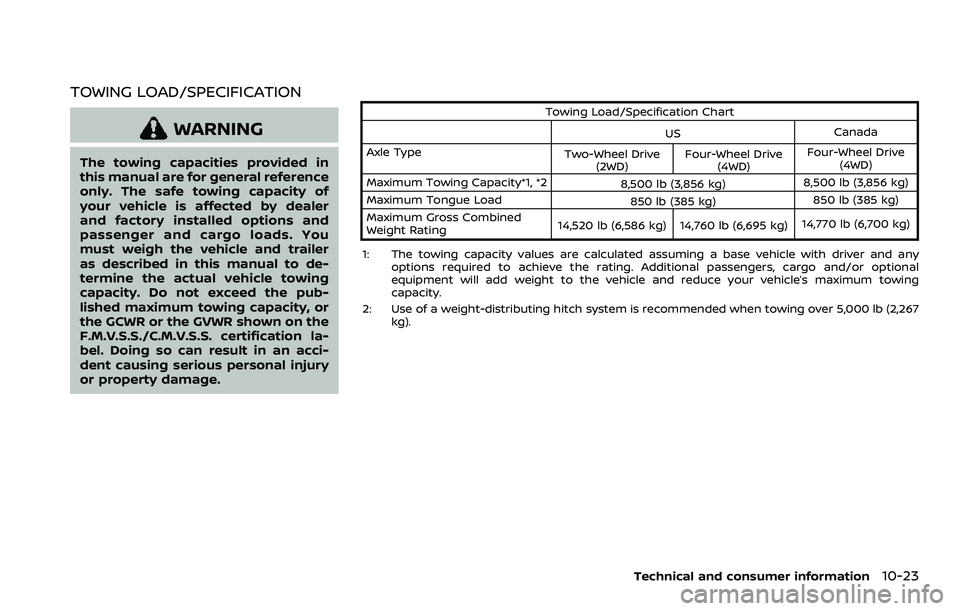
TOWING LOAD/SPECIFICATION
WARNING
The towing capacities provided in
this manual are for general reference
only. The safe towing capacity of
your vehicle is affected by dealer
and factory installed options and
passenger and cargo loads. You
must weigh the vehicle and trailer
as described in this manual to de-
termine the actual vehicle towing
capacity. Do not exceed the pub-
lished maximum towing capacity, or
the GCWR or the GVWR shown on the
F.M.V.S.S./C.M.V.S.S. certification la-
bel. Doing so can result in an acci-
dent causing serious personal injury
or property damage.
Towing Load/Specification ChartUS Canada
Axle Type Two-Wheel Drive
(2WD) Four-Wheel Drive
(4WD) Four-Wheel Drive
(4WD)
Maximum Towing Capacity*1, *2 8,500 lb (3,856 kg)8,500 lb (3,856 kg)
Maximum Tongue Load 850 lb (385 kg)850 lb (385 kg)
Maximum Gross Combined
Weight Rating 14,520 lb (6,586 kg) 14,760 lb (6,695 kg)
14,770 lb (6,700 kg)
1: The towing capacity values are calculated assuming a base vehicle with driver and any options required to achieve the rating. Additional passengers, cargo and/or optional
equipment will add weight to the vehicle and reduce your vehicle’s maximum towing
capacity.
2: Use of a weight-distributing hitch system is recommended when towing over 5,000 lb (2,267 kg).
Technical and consumer information10-23
Page 532 of 603

10-24Technical and consumer information
TOWING SAFETY
Trailer hitch
Your vehicle is equipped with a trailer tow
package. The trailer tow package in-
cludes a receiver-type frame mounted
hitch. This hitch is rated for the maximum
towing capacity of this vehicle when the
proper towing equipment is used. Choose
a proper ball mount and hitch ball that is
rated for the trailer to be towed. Genuine
NISSAN ball mounts and hitch balls are
available from a NISSAN dealer.
WAJ0218X
To access the trailer hitch, remove the
trailer hitch cover located on the lower
part of the rear bumper.
To remove the trailer hitch cover:
1. Remove the 2 clips.
2. Pull the bottom of the cover straight backward to remove the inner side and upper clips.